
By James Connors, Web Coordinator - NOAA Office of Ocean Exploration and Research
As children, we all heard the adage “where there’s smoke, there’s fire”, whether in the context of actual fire, or used metaphorically to describe some event that seems to always be causally connected to another. The adage seems true enough on land, but here in the deep-sea the connection can be a bit ‘murky’, in every sense of the word.
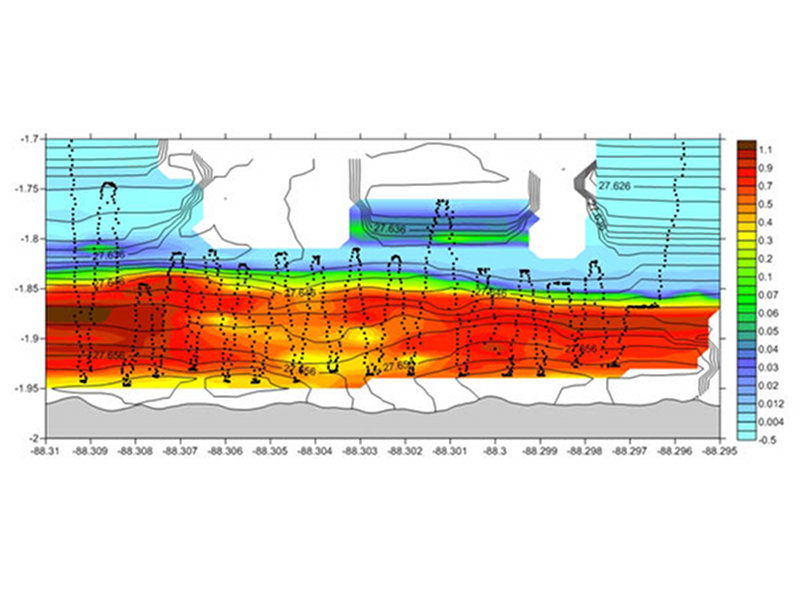
To try and close range on the location of the vents near the 2a site, EX ran a CTD tow-yo along the axis after Dive 2. The black dotted line marks the up-and-down path of the CTD as the ship tows it through the water. The tow found a continuous plume along more than a mile of track line, with some turbidity values higher than anything measured during Leg 1. The highest values were found near the western end of the track, with some lower values near the middle. Image courtesy of NOAA Office of Ocean Exploration and Research. Download larger version (jpg, 503 KB).
After the expedition’s inaugural dive on the Paramount Seamounts, the science team decided to head southeast to explore a number of sites identified on the CTD/mapping leg as having the anomalous temperature and light readings characteristic of active hydrothermal vents. One site in particular, labeled ‘2a’ by the team, has light-scattering properties dozens of meters off the seafloor, a sign of the intense ‘smoke’ plumes (actually clouds of fine particulate material emitted by vents) that typically emanate from vent fields. Often vents are difficult to detect even a few meters from their base on the seafloor, so the presence of very obvious vent-fluid smoke 30 meters up in the water column was enough to convince the team that the ‘fire’—in this case, super-hot sites where the heated hydrothermal fluids make contact with cold seawater—would be present, and to devote several dives to the area.
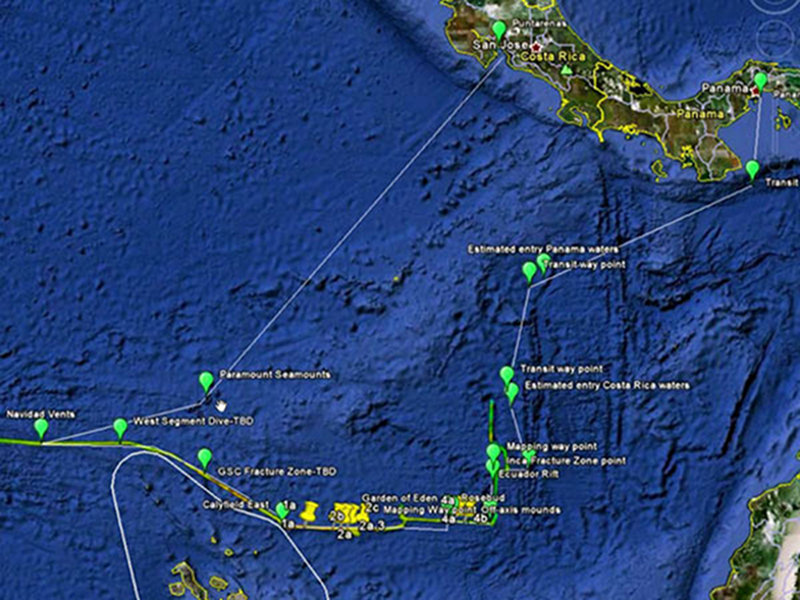
The original cruise plan overlaid in Google Earth, showing proposed dive targets 1-4 along with many previously identified sites along the Galápagos Rift. Image courtesy of NOAA Office of Ocean Exploration and Research. Download larger version (jpg, 603 KB).
Now that three dives have been completed around 2a, the adage is beginning to lurk mockingly in the back of everyone’s mind. On every dive, huge billows of vent smoke have been seen as Little Hercules and Seirios are maneuvered about 20 to 80 meters above the seafloor. The sheer thickness and expanse of the suspended plume, rendering visibility to almost zero at times, is direct evidence for active venting. Yet Little Hercules has still not imaged any expansive vent fields. Relatively small pockets of ‘diffuse venting’, where what appears to be warm hydrothermal fluids (Little Hercules does not have the capability of measuring vent fluid temperatures) seep through the surrounding basaltic rock, have been observed, but nothing that would explain the huge expanse of smoke seen above. Furthermore, only meager traces—a species of fish here, marks on no-longer active polymetallic sulfide chimneys from former tube worm attachment there—of the biological communities typically associated with hydrothermal vents have been present.
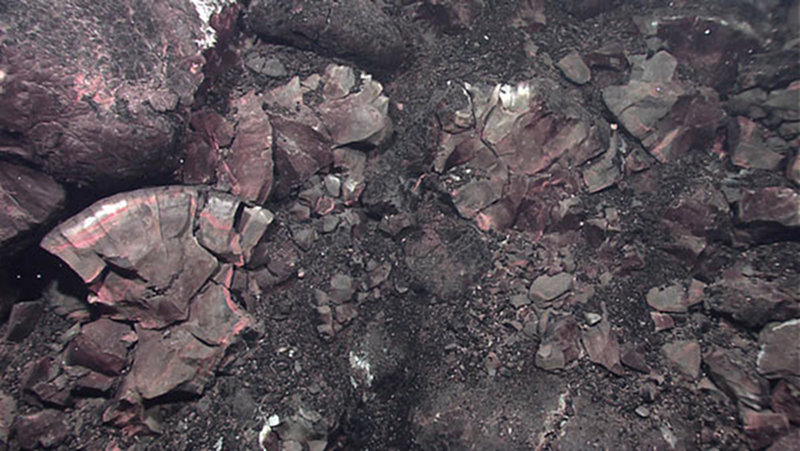
Chunks of pillow lava that cooled rapidly enough to produce a glassy surface and relatively sharp fractures. Image courtesy of NOAA Office of Ocean Exploration and Research. Download larger version (jpg, 1.7 MB).
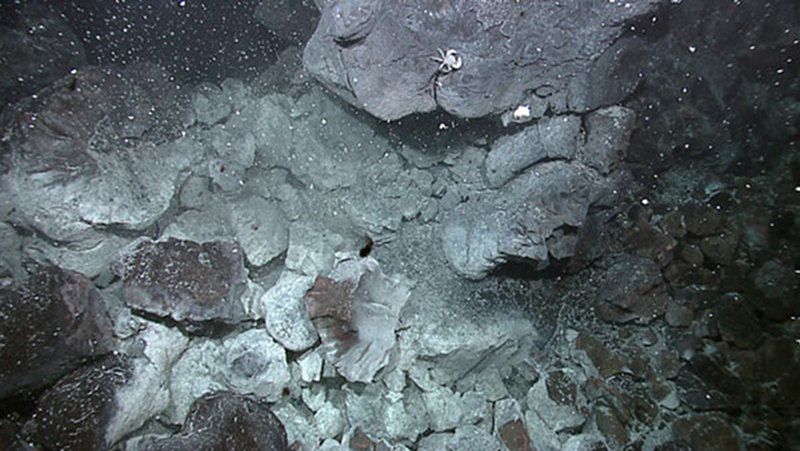
A recent lava flow showing white microbial staining on the broken basaltic rocks, caused by discharge of warm hydrothermal fluids through the seafloor. Image courtesy of NOAA Office of Ocean Exploration and Research. Download larger version (jpg, 1.6 MB).
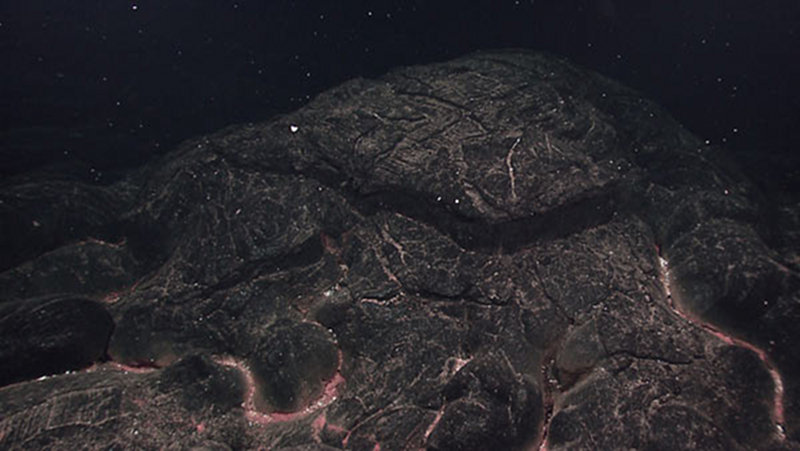
A recent pillow lava flow with biological material resting between the pillows, indicating where low-temperature hydrothermal fluid has been leaking out of the crust. Image courtesy of NOAA Office of Ocean Exploration and Research. Download larger version (jpg, 1.4 MB).
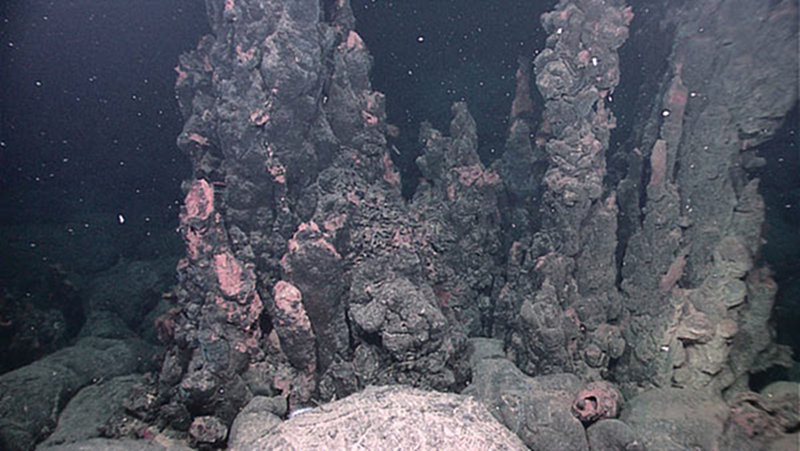
A field of extinct sulfide chimneys, several meters high, rise above the surrounding seafloor. The pink staining is a combination of biological and chemical processes. Image courtesy of NOAA Office of Ocean Exploration and Research. Download larger version (jpg, 1.8 MB).
The ROV has seen many other interesting, closely associated phenomena (massive extinct black smoker chimneys, pillow lava, bacterial mats, oxide staining) that give the geologists and microbiologists equal cause for excitement, but the presumed but as-yet-unseen black smoker vents have brought into question the terrestrial rationale that fire can always be found near smoke.